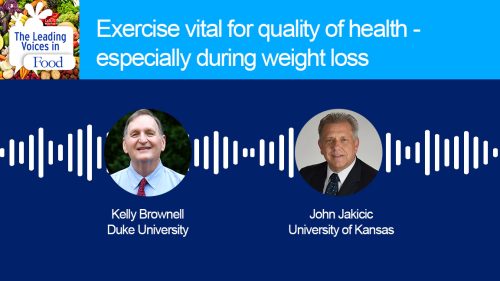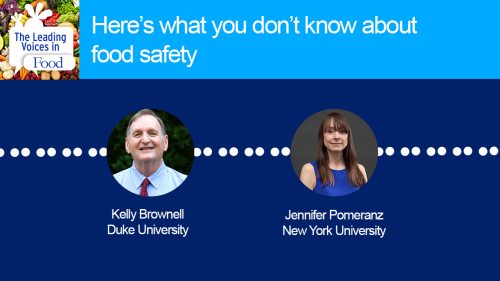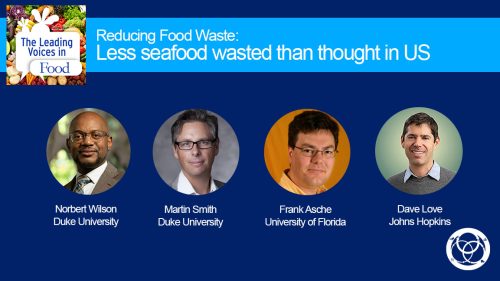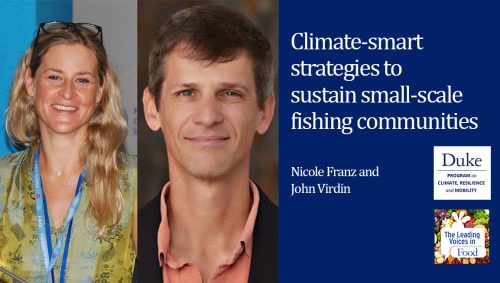The Leading Voices in Food
E133: Measuring Fish for Food & Nutrition Security – Improving Metrics to Advance Policy
Public Policy relies on strong data and measurements. So if you want to improve a development target like nutrition, you need to be able to measure that. But with fisheries and aquaculture, we often don’t have the metrics we need to make sound policy decisions. This podcast is a part of a series on fisheries and nutrition and a movement to bring fisheries into international food policy and programming.
Subscribe: Apple Podcasts | TuneIN | YouTube Music | SoundCloud | PocketCasts | Radio Public
Tags: Diet & Nutrition | Fisheries & Food Policy |

Dr. Christopher Golden is an Assistant Professor of Planetary Health and Nutrition at the Harvard T.H. Chan School of Public Health. As an ecologist and epidemiologist, his research investigates the human health impacts of global environmental change, with a focus on food systems. He received his BA from Harvard College and two graduate degrees from UC Berkeley: an MPH in Epidemiology with a focus in Nutrition, and a PhD in Environmental Science, Policy and Management. Golden has been conducting research in Madagascar for the past 20 years, and has recently begun research in West Africa and the South Pacific. He is a core member of the CBD-WHO task force on biodiversity and health, the Lancet Food Systems Countdown, and the co-lead of the Nutrition chapter for the Blue Foods Assessment. His research has been published in Nature, Science, and the Proceedings of the National Academy of Sciences. His current research focuses on: 1) climate-driven fisheries impacts across the globe on food security and human nutrition; 2) the role of coral reef management in increasing access to seafood and reducing diabetes and metabolic disease; and 3) creating systems of climate-smart public health.
Nicole Franz is a development economist with 18 years of experience in intergovernmental organizations. She holds a Master in International Cooperation and Project Design from University La Sapienza, Rome and a Master in Economic and Cultural Cooperation and Human Rights in the Mediterranean Region. From 2003 to 2008 she was a consultant for the Food and Agriculture Organization of the United Nations (FAO) and the International Fund for Agricultural Development (IFAD). In 2009-10 she was Fishery Planning Analyst at the Organization for Economic Cooperation and Development (OECD) in Paris, focusing on fisheries certification. Since 2011 she works for the FAO Fisheries Division where she coordinates the implementation of the Voluntary Guidelines for Securing Sustainable Small-Scale Fisheries in the Context of Food Security and Poverty Eradication (SSF Guidelines) with a focus on inclusive policy processes and stakeholder empowerment. Since 2021 she leads the Equitable Livelihoods team.
Interview Summary
Welcome to the Leading Voices in Food podcast. I’m Sarah Zoubek, associate director of the World Food Policy Center at Duke University. My co-host today is World Food Policy Center alum and Michigan State University, fisheries social scientist Abigail Bennett.
We’ve got another full house of guests today with Harvard T.H. Chan School of Public Health’s ecologist and epidemiologist, Chris Golden and fisheries planning analyst, Nicole Franz at the United Nations Food and Agriculture Organization, FAO.
So I’ll just jump right in, garbage in and garbage out, is what I often hear researchers say when referring to making decisions based on bad data or essentially no data. In your view, what are some of the most important data and information gaps for fisheries and aquaculture, and then subsequently for developing policy that promotes their contributions to food and nutrition security.
Chris – One of the most interesting things is that as a society, we still don’t know who is eating what and where. So we have all of this data on food production around the world. We have data on trade in many cases, but we don’t really know who’s eating things. What types of food they’re eating, why they’re eating it. And so all of these data are essential for us to understand food behaviors, nutritional status, and the emergence of sustainable food systems. Thinking about aquatic foods, we also have these same types of issues. Consumption data is really patchy. We also really don’t understand how food is being distributed geographically within a nation by socioeconomic status, age group, or gender dynamics, we really struggle to understand how policies that increase aquatic food production or environmental changes that might shock aquatic food production, might have downstream effects on people’s lives.
Nicole – Chris, you already pointed out really crucial gaps. So I would just like to compliment with two more. And the first relates to the nutritional value of diverse types of aquatic foods. Aquatic foods provide micronutrients and essential fatty acids, and obviously in a very different way between these different products. The nutritional value of a white fish filet is very different from the nutritional value of a portion of small dried fish that is consumed whole. And this small dried fish for example, is particularly important as part of the diet of large amounts of people, particularly in Africa, but also in Asia. So better understanding those nutritional values of the different aquatic food products can really make a major difference in ensuring that those who are most in need have access to highly nutritious and aquatic foods. For example, one way to use that knowledge and apply that information is through targeted school feeding programs.
A second data and information gap relates to the origin of aquatic food supplies. We often talk about catch about the production volume but there’s less information currently available on the underlying production system. So who is catching that fish and what species is produced by what kind of production system. National catch statistics are usually not differentiating for example between large scale and small scale fisheries. But knowing these underlying production systems is really of crucial importance to inform food security and nutrition sensitive policies. Small-scale fisheries for example, they tend to fish a larger variety of species than industrial fisheries. And this variety then also tends to be consumed while what is coming from industrial fisheries, a good part of the catch is often not used for human consumption.
In 2012, the World Bank, FAO and WorldFish worked together on a study that was called Hidden Harvest: The Global Contribution of Capture Fisheries. And in that study, it emerged that half of the global catch in developing countries is in fact produced by small scale fisheries. Even more importantly, the study found that between 90 and 95% of the small scale fisheries landings are destined directly for human consumption. So this really provides a strong justification to understand what the underlying production system is, because it has policy implications.
Abigail – Nicole I’d like to ask you a little bit more about the Illuminating Hidden Harvest study that you mentioned and the kinds of data and metrics it uses to understand the contributions of small scale fisheries in particular to food and nutrition security.
Nicole – Thanks Abby. In fact, the Illuminating Hidden Harvest study was inspired by the 2012 Hidden Harvest study. It is expanding the scope to better capture the nutrition and food security aspects in relation to small scale fisheries. So we’re partnering with WorldFish and with Duke University for the production of this Illuminating Hidden Harvest study. And this is an attempt to contribute to closing, or maybe at least narrowing some of the current data and information gaps by providing more evidence on how small scale fisheries in particular contributes to sustainable development. The methods we have developed consists in data that we collected from 58 countries and territories. We also have submitted a survey that was replied to by over 100 countries, and we’re also drawing on existing global databases. So we’re combining all of this information in order to better understand the contribution of small scale fisheries to sustainable development.
One of the things we’re doing in the nutrition work is building on work that was conducted by Christina Hicks from Lancaster University to model the nutrient content from fish. This is also an attempt to model nutrient content more widely, and this should be helping to value catch in terms of nutrition rather than only in terms of economic value. The catches from small scale fisheries are really very valuable in terms of nutrient richness, especially in terms of calcium of iron and zinc. And these are three nutrients that are often lacking in the diets in particular in low and middle-income countries. So these findings are incredibly important from a policy standpoint because they’re showing the need to secure small-scale fisheries production systems in the context of growing competition over access to water in coastal areas, but it really underlines the need to maintain those important food production systems that are servicing so much nutrients to in particular, the most vulnerable and marginalized parts of populations.
Within the Hidden Harvest study, we’re also using an indicator of household proximity to fisheries to understand better how the consumption of fish supports the nutritional benefits of the consumers. And this has really helped to illuminate how important fisheries are for the diets, especially for some groups within the population, including children between six and 24 months, which is really critical window for nutrition. So having access to affordable nutritious aquatic food is fundamental and using this indicator of household proximity to fisheries, has really helped us to visualize how the benefits from small scale fisheries are distributed within a country.
Abigail – Thanks, Nicole, that’s really exciting. How can listeners access the results when they’re available or keep up with the study as it progresses?
Nicole – We have a website and we’re also sending out newsletter and we’re sharing how the study is progressing. And we are planning to release a study at the end of the year, and it will obviously be available online on the pages of the three three partner organizations, FAO, WorldFish and Duke University.
Sarah – Chris, you had mentioned various databases. Can you explain a little bit more how that’s filling the data gaps for diet and nutrient considerations for fisheries and aquaculture? What are we measuring here?
Chris – There are so many different types of databases in different parts of the world being produced by different users and all of them are so important, particularly in the ways that they can be used together. I’m going to list the ones that I’ve used in my own work or am aware of. The Global Nutrient Database is jointly produced by FAO (the Food and Agriculture Organization) and IHME (the Institute for Health Metrics and Evaluation). And it produces an integrated nutrient supply estimate for all foods that are produced with the expectation that they are being consumed at the national level. And so you have consumption data that is then matched under nutrient composition tables to understand approximately the nutrient supply at the national level. If you do some modeling to estimate how those national supplies are being consumed at sub national level across age and sex groups, you can actually make estimates of nutrient deficiencies at the national level. This becomes really important in terms of targeting what types of food interventions or nutritional interventions need to be undertaken at national scales.
There’s also something called the Global Dietary Database based at Tufts University that has aggregated most of the world’s 24 hour recall data considered to be the gold standard for dietary assessment and has aggregated all data that was conducted in nationally representative ways, I think it’s for more than 80 countries, to understand how food items are consumed, how they’re distributed sub nationally. And so the information within that, that allows us to have an idea of how the Global Nutrient Database might be disaggregated at sub-national scales.
There’s also a database called GENuS, Global Expanded Nutrient Supply Database. This is a unique database in that it is completely open access, it can be found online in the Harvard Dataverse and it also produces nutrient supply estimates that uses the FAOs food balance sheet data, and then assigns nutrient composition data to the food balance sheet data and corrects for ways in which production might actually be translated into consumption.
The last thing that I’ll mention is that we have recently developed something called the Aquatic Food Composition Database. We noticed how important the diversity of production systems of species, of the parts of fish that people were consuming and how little we knew about the nutrient value of those different parts of fish. And we went through a systematic scoping review of all of the data that was available in the peer reviewed literature. We went through all of the national food composition tables, and we wove that together into one integrated database and we called it the Aquatic Food Composition Database. And this has more than 3000 different aquatic food species, inclusive of both plant and animal source foods, an entire suite of different nutrients. From iron, zinc, individual fatty acids, protein, vitamin A, vitamin B12, etc. And then also classifies data based on whether it was wild, farmed, what geographical region it was produced in, and the part of the fish that is being tested. So whether it’s the filet, the liver, a whole fish, whether it’s dried or fresh. So any processing that is involved before the nutrient analysis was done. I think with all of these different methods, all of these different databases, putting together all of these data and disparate parts, and these unconnected databases will be incredibly important to understanding how we can create more efficient, more sustainable and more nutritious food systems.
Abigail – Chris and Nicole, you both laid an amazing amount of work out on the table. And it’s really exciting because it does seem like the field is inching closer to being able to connect some of those dots and do some triangulation on some areas where there’s some uncertainty and data gaps. And so yeah, I do want to circle back around to this initial question that we posed, which is so what is the significance of this work collectively for policymaking? What does this data enable us to measure about fisheries and agriculture and what are some of the implications for making better policy?
Chris – I think one of the things to look at is the way that the aquaculture industry is really revolutionizing feed. We know that aquatic foods on average are so much more sustainable and have a much lighter environmental footprint than a vast array of different forms of animal source foods. So when we put it in that context, to think about the way in which feed products that go into agriculture, which is the dominant form of environmental impact for most of them and the way that they’re being completely transformed by these interesting tech companies, to look at ways that we can use plant feeds with adopted or generated nutrient profiles that really improve the ultimate end product of nutrition. I think that that is something to definitely keep a lookout for, that will have incredible policy impact in terms of developing sustainable food systems.
And so one of the things that my team has been looking at is the degree to which fisheries management and specifically marine protected areas, could actually serve as a nutritional intervention. Conservation as a process could actually be not only a biodiversity and an environmental intervention, but also a public health intervention. And so the idea that a marine protected area could rehabilitate a fishery, provide spillover and increasing access to seafood to adjacent communities, is something that I think is so exciting to really reframe that mentally. And then to see if we can actually quantify the benefits of conservation to human health.
Abigail – And Chris does that serve as even an additional justification for fisheries conservation? Is it useful in that sense as well to kind of reframe these things like that?
Chris – I think so, absolutely. I think the degree to which we can think of all of these different sectors as serving multiple different purposes of the resource. And so to think of fisheries exclusively in an economic sense, really undermines so much of its true value and might lead to mismanagement from a fisheries management standpoint.
Abigail – Nicole, I want to turn it over to you and ask the same question. What types of policies do you think might emerge from a lot of the work in filling data and information gaps?
Nicole – I fully agree with what Chris just mentioned, and I think hopefully one of the major results of better data and information is that there’s more integrated analysis across different policy domains, such as fisheries and nutrition. It would really allow for more coherence also across new policies. For example, these broader livelihood dimensions that are coming from the fisheries are really emerging and are valued. So by having this data, the fishery sector will really gain more recognition because currently we see often that it’s overlooked, it’s not taken into account even in food security and nutrition strategies in many countries. So by having more evidence about these values and these multiple functions of aquatic food within societies, this really should help better policy making and help to optimize the outcomes of these different policies that are playing together in a more coherent way.
There are a number of new global policy processes and policy instruments developing, taking aquatic foods more into consideration. One example are the Voluntary Guidelines for Food Systems and Nutrition. These Voluntary Guidelines were endorsed earlier this year and they specifically include aquatic foods. And we also see now in the preparations for the UN Food Systems Summit, that aquatic foods is entering more and more the preparatory process of this UN Food Systems Summit. They often call it blue foods instead of aquatic foods. But we see now that the attention is growing and that the number of informal dialogues and the number of events are organized around that theme because there is this recognition, that aquatic food is really part of the system and it generates all of these health benefits, which ultimately play out positively for society.
Sarah – And now one final question. What are you most excited about that’s on the horizon for aquatic, or as Nicole said, blue foods?
Nicole – I’m excited about this increasing recognition of aquatic foods, beyond the fisheries policy domain. And one example, there’s the UN, they just released for the first time a discussion paper specifically on the role of aquatic foods in sustainable healthy diets. I think that that is really quite important. This paper sets out a number of recommendations on how aquatic foods are part of the solution to really building resilient food systems and sustainable, healthy diets. There’s one recommendation that specifically calls to democratize knowledge, data, and technologies, and to co-create meaningful knowledge and usable innovations. And that recognition of the role of data and information in this report, I think is quite powerful. And I hope that it will really kick off more work and more attention, and also the possibility to bring together all of the existing knowledge. Chris mentioned before, there are so many databases already out there, there’s so much information, but this might be an opportunity to really connect all of these better and build analysis around it, that then can really be the evidence base for policy making in the future.
Chris – I completely agree with Nicole, this increasing recognition of fish and aquatic food products, it is incredibly important to elevate this recognition of how undervalued aquatic foods have been in the global food system. And one of the things I’m most excited about is not only raising the profile of that, but also integrating it and linking it directly into the terrestrial food system. We can’t any longer deal with these two things as separate entities. There are enormous feedbacks in terms of the forage fish that are then used as fertilizer or feeds in terrestrial food systems, and the ways in which terrestrial food production, then leaches into affecting our rivers and lakes and coastal water systems. We can’t think of these things as detached. We have to think of them as one integrative and holistic food system.
Sarah – I wanted to mention, Chris, the paper that you noted is called Recognize Fish as Food in Policy Discourse and Development Funding.






